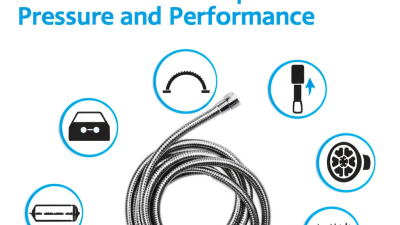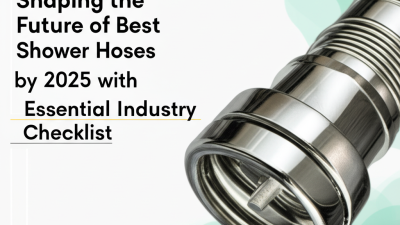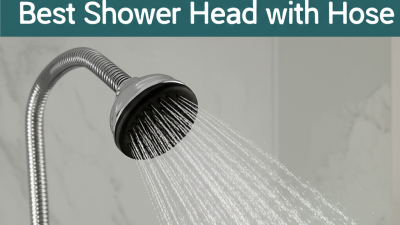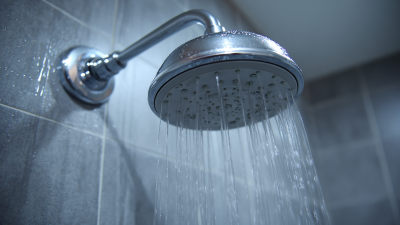
How to Choose the Right Shower Hose for Optimal Water Pressure and Performance
 When it comes to enhancing your bathroom experience, the importance of selecting the right shower hose cannot be overstated. A well-chosen shower hose can significantly influence water pressure and overall performance during your daily routines. With a plethora of options available on the market, from varying lengths and materials to different connector types, making an informed decision can be quite overwhelming. Choosing the correct shower hose not only ensures a consistent and enjoyable flow of water but also contributes to the longevity and maintenance of your shower system. This guide aims to equip you with the essential knowledge needed to navigate the selection process, enabling you to find the perfect shower hose that meets your needs and complements your bathroom design.
When it comes to enhancing your bathroom experience, the importance of selecting the right shower hose cannot be overstated. A well-chosen shower hose can significantly influence water pressure and overall performance during your daily routines. With a plethora of options available on the market, from varying lengths and materials to different connector types, making an informed decision can be quite overwhelming. Choosing the correct shower hose not only ensures a consistent and enjoyable flow of water but also contributes to the longevity and maintenance of your shower system. This guide aims to equip you with the essential knowledge needed to navigate the selection process, enabling you to find the perfect shower hose that meets your needs and complements your bathroom design.
Understanding the Importance of Shower Hose Quality for Water Pressure
When selecting a shower hose, understanding the importance of quality cannot be overstated, especially considering its impact on water pressure and performance. According to a report from the American Society of Plumbing Engineers, about 30% of residential plumbing issues stem from substandard hoses, leading to reduced water flow and pressure. A well-crafted shower hose can maintain optimal pressure, providing a consistent and enjoyable shower experience.
High-quality shower hoses are typically made from materials like stainless steel or reinforced rubber, which not only resist kinks and leaks but also ensure longevity. A study by the Plumbing Manufacturers International indicated that using a durable shower hose can improve water pressure by up to 25%, significantly enhancing the overall performance of your shower system.
Furthermore, features such as anti-twist mechanisms can contribute to maintaining a steady flow, allowing users to enjoy their showers without the frustration of decreasing pressure. Therefore, investing in a quality shower hose is crucial for anyone looking to optimize their daily bathing routine.
Key Factors to Consider When Selecting a Shower Hose for Performance
When selecting a shower hose for optimal water pressure and performance, several key factors must be taken into account. First and foremost, the length of the hose is crucial. A longer hose allows for more flexibility in positioning your showerhead, which can enhance the overall shower experience. However, excessive length can lead to a decrease in water pressure due to friction. Therefore, it’s essential to choose a length that provides convenience without compromising pressure.
Material is another vital consideration. Shower hoses are commonly made from stainless steel, plastic, or rubber, each offering distinct advantages. Stainless steel hoses are durable and resistant to kinking, ensuring a consistent flow. On the other hand, plastic hoses may be lighter and more flexible but might not withstand heavy usage over time. Additionally, checking the inner diameter of the hose is important: a larger diameter can improve water flow and pressure, while a smaller diameter may restrict performance. By weighing these factors, you can choose a shower hose that meets your specific needs and enhances your daily shower experience.
Material Choices: Comparing Metal, Plastic, and Other Options for Shower Hoses
When selecting a shower hose, the choice of material is fundamental to achieving optimal water pressure and performance. Metal hoses, often made from stainless steel, are renowned for their durability and resistance to kinking. They can handle high water pressures and are less prone to wear and tear over time. However, they may be heavier and can result in a more rigid installation, which could be a consideration in smaller bathrooms.
On the other hand, plastic shower hoses are lightweight and flexible, making them easier to handle and install. They are often less expensive, which can be an attractive feature for budget-conscious consumers. However, their susceptibility to cracking or kinking may lead to reduced longevity and performance. Some newer options include reinforced plastic hoses, which offer a blend of flexibility and enhanced durability. By carefully weighing the pros and cons of metal versus plastic hoses, consumers can make an informed decision that aligns with their showering needs and bathroom aesthetics.
Length and Flexibility: Finding the Ideal Measurements for Your Shower Space
When selecting the right shower hose, the length and flexibility are crucial factors that influence both water pressure and overall performance. According to a report by the Plumbing Manufacturers International, a standard shower hose typically measures between 59 to 79 inches long, providing enough reach for most shower configurations. However, opting for a longer hose can enhance convenience, particularly in larger shower spaces or for users with specific mobility needs. A hose that is too short may limit your movement, thereby affecting both comfort and water flow.
Flexibility is equally essential, as a rigid hose can create kinks that obstruct water flow, leading to reduced pressure. A study published in the Journal of Water Resources Planning and Management found that flexible hoses made from materials like stainless steel or rubber are more likely to maintain consistent water pressure compared to their less flexible counterparts. Ideally, a flexible hose should seamlessly bend and move with the user while maintaining its shape, ensuring a consistent and enjoyable shower experience. Selecting a hose that balances the right length with optimal flexibility can significantly enhance your daily routine.
Installing and Maintaining Your Shower Hose for Optimal Performance
Installing a shower hose correctly is crucial for achieving optimal performance and water pressure. Begin by ensuring that the hose is compatible with your showerhead and fixture. A good fit will prevent leaks and maintain consistent water flow. When installing, securely attach one end to the showerhead and the other to the water supply, making sure all connections are tightened but not over-tightened, which could damage the hose. It's important to pay attention to the orientation of the hose; avoid kinks and twists, as these can impede water flow and pressure.
Regular maintenance of your shower hose is essential for longevity and performance. Periodically check for signs of wear, such as cracks or leaks, and replace the hose if necessary. Cleaning the hose can also improve water flow—simply use a mixture of vinegar and water to remove mineral buildup. Additionally, inspect the washers and connectors, replacing them if they appear worn out. By taking these steps, you can ensure your shower hose operates at peak efficiency, providing a consistent and enjoyable shower experience.
How to Choose the Right Shower Hose for Optimal Water Pressure and Performance
| Dimension | Optimal Value | Impact on Performance |
|---|---|---|
| Hose Length | 59 inches (150 cm) | Allows comfortable movement without kinking |
| Hose Diameter | 1/2 inch (12.7 mm) | Ensures adequate water flow for optimal pressure |
| Material | Stainless Steel | Resistant to corrosion and damage, enhancing longevity |
| Flexibility | High Flexibility | Prevents kinking; easy to maneuver |
| Connection Type | Universal Fit | Easily compatible with various showerheads and faucets |
| Weight | Lightweight | Easy handling and reduces stress on connections |
Related Posts
-

Innovative Technologies Shaping the Future of Best Shower Hoses by 2025 with Essential Industry Checklist
-

Ultimate Checklist: Top 5 Features to Look for in the Best Shower Head with Hose
-

Ultimate Kitchen Shower Hose Checklist: Ensure You Choose the Perfect Fit for Your Home
-

Unlocking Global Standards for Best Shower Set System Your Ultimate Certification Guide
-

The Ultimate Checklist for Choosing the Perfect Concealed Shower Set
-

Mastering Your Space: A Step-by-Step Guide to Installing a Black Shower Faucet Set



